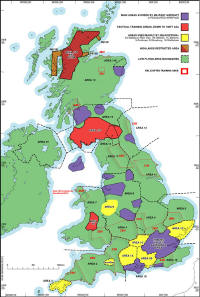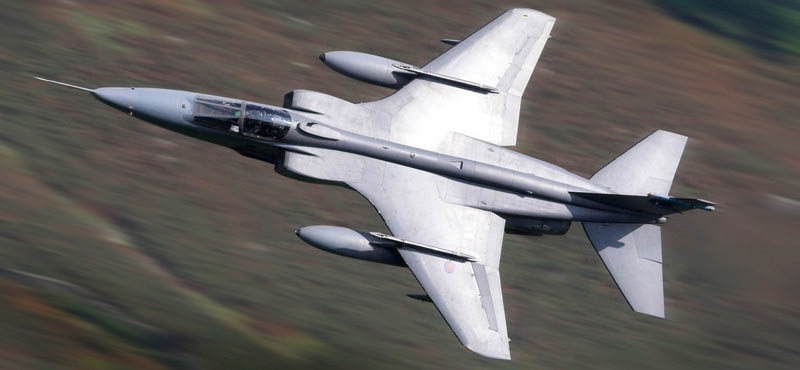Low flying is an essential and
demanding skill that requires constant practice to ensure that
should the need arise, crews of both fixed wing and rotary aircraft are
able to perform their task over any terrain. Low level operations aren't
restricted to strike attack; troop transportation, search and rescue,
humanitarian relief and even air defence can and is often carried out at
low level.
| The UK Military Low
Flying System (UKLFS) covers the open airspace of the whole of the
UK and surrounding overseas areas from the surface to 2,000 feet
above the ground or mean sea level. Low flying training takes place
across most areas with the country divided into some 19
separate Low Flying Areas (LFAs). With the exception of major urban
conurbations (population exceeding 10,000) and certain industrial
locations, crews almost have a fee reign over their flight planning
when conducting low level operations.
In the
UK, fixed aircraft are considered to be low flying when operating
below 2000ft and helicopters and light prop aircraft below 500ft.
Fixed wing aircraft are required to maintain a minimum separation of
250ft from objects and terrain, although within designated areas of
three LFAs this limit is reduced down to 100ft. Within these
designated areas, (Known as Tactical Training Areas - TTAs) other
aircraft are required to remain above 500ft whilst the TTA is
active. Training at 100ft is actually quite rare and accounts for
less than 1% of the total fixed wing flying hours each year.
(minimum separation distance is defined as the distance that must be
maintained between any part of an aircraft in flight and the ground,
water or any object. It does not apply to separation between
aircraft in the same formation). |
Where are the LFAs? |
|
 |
By spreading the low flying training around the whole of
the UK the Ministry of Defence aims to reduce the disturbance to any
individual area and as such each mission must be planned in advance along
with a booking in and out procedure through the low fly cell based at RAF
Wittering in Cambridgeshire. it is the job of the low fly cell to ensure
an even spread of activity by limiting the number of aircraft allowed
within any LFA at any given time.
_small1.jpg) |
To prevent aircrew becoming over
familiar with particular areas and therefore over confident, once in
an LFA the routing is determined by the crews to maximise the
training opportunity available., with the exception of a small
number of flowed valleys the crews can operate at their discretion.
The decision to flow certain valleys (restricting fixed wing flights
to one way) was following a number of accidents and near misses
within the LFS. By routing aircraft in only one direction the number
of reported near misses and accidents has dropped significantly. It
is no coincidence that the flowed valleys are also the most popular
amongst photographers, the narrow valleys offer choke points where
the aircraft are literally funnelled through open country and past
the camera location. |
Five of the LFAs are known as Dedicated User Areas and
are assigned to certain bases or organisations, LFA 13 for example
supports Electronics Warfare (EW) range at RAF Spadeadam, whilst LFA1 and
9 are dedicated to AAC Middle Wallop and RAF Shawbury respectively.
Further information about the UKLFS can be found on the
Ministry of Defence website
|



_small1.jpg)